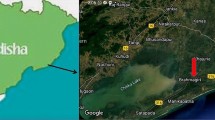Abstract
Spirals, the most common equipment for the separation of heavy minerals such as chromite, are greatly affected by size distribution and the liberation degree (hence the specific gravity and size) of the feed particles. In this study, the efficiency of spirals in separation of low-grade chromite particles has been investigated by studying the distribution of grade, size distribution and liberation degree of feed, concentrate, and tailings of spiral. For this purpose, mass balance constraints were applied to the spiral-containing chromite processing circuit. Afterwards, the grade variations and size distributions have been investigated. According to the results, when the feed to the spiral has a larger size distribution, the enrichment ratio of the feed is 1.32 and, with the smaller feed size, this value has increased to 1.99. When the spiral feed has a larger size distribution and higher specific gravity, the recovery of chromite increases with increasing particle size up to 250 microns, and then with increasing particle size, recovery decreases with a relatively steep slope. Evaluation of spiral efficiency with respect to particle liberation degree has also shown that despite the high degree of liberation of spiral feed in size fractions smaller than 75 microns (88.9%), the liberation degree of spiral concentrate and tail in this faction is equal to and less than that of feed, which can indicate poor spiral performance in these size fractions.








Similar content being viewed by others
References
Atasoy Y, Spottiswood DJ (1995) A study of particle separation in a spiral concentrator. Miner Eng 8:1197–1208. https://doi.org/10.1016/0892-6875(95)00084-4
Burt RO (1984) Gravity concentration technology. In Developments in mineral processing
Mishra BK, Tripathy A (2010) A preliminary study of particle separation in spiral concentrators using DEM. Int J Miner Process 94:192–195. https://doi.org/10.1016/j.minpro.2009.12.005
Honaker RQ, Jain M, Parekh BK, Saracoglu M (2007) Ultrafine coal cleaning using spiral concentrators. Miner Eng 20:1315–1319. https://doi.org/10.1016/j.mineng.2007.08.006
Murthy YR, Tripathy SK, Kumar CR (2011) Chrome ore beneficiation challenges & opportunities - a review. In Minerals Engineering 24:375–380. https://doi.org/10.1016/j.mineng.2010.12.001
Öztürk FD, Abakay Temel H (2016) Beneficiation of Konya-Beyşehir chromite for producing concentrates suitable for industry. JOM. 68:2449–2454. https://doi.org/10.1007/s11837-016-1983-1
Dixit P, Tiwari R, Mukherjee AK, Banerjee PK (2015) Application of response surface methodology for modeling and optimization of spiral separator for processing of iron ore slime. Powder Technol 275:105–112. https://doi.org/10.1016/j.powtec.2015.01.068
Falconer A (2003) Gravity separation: old technique/new methods. Phys Sep Sci Eng 12:31–48. https://doi.org/10.1080/1478647031000104293
Gulsoy OY, Kademli M (2006) Effects of operational parameters of spiral concentrator on mica-feldspar separation. Transactions of the Institutions of Mining and Metallurgy, Section C: Mineral Processing and Extractive Metallurgy 115:80–84. https://doi.org/10.1179/174328506X99907
Boucher D, Deng Z, Leadbeater T, Langlois R, Renaud M, Waters KE (2014) PEPT studies of heavy particle flow within a spiral concentrator. Miner Eng 62:120–128. https://doi.org/10.1016/j.mineng.2013.12.022
Jain PK, Rayasam V (2017) An analytical approach to explain the generation of secondary circulation in spiral concentrators. Powder Technol 308:165–177. https://doi.org/10.1016/j.powtec.2016.11.040
Nienaber EC, McCoy JT, Auret L (2017) Spiral concentrator interface monitoring through image processing: a statistical learning approach. IFAC-PapersOnLine. https://doi.org/10.1016/j.ifacol.2017.12.010
Tripathy SK, Rama Murthy Y (2012) Modeling and optimization of spiral concentrator for separation of ultrafine chromite. Powder Technol 221:387–394. https://doi.org/10.1016/j.powtec.2012.01.035
Bazin C, Sadeghi M, Bourassa M, Roy P, Lavoie F, Cataford D, Rochefort C, Gosselin C (2014) Size recovery curves of minerals in industrial spirals for processing iron oxide ores. Miner Eng 65:115–123. https://doi.org/10.1016/j.mineng.2014.05.012
Fuerstenau MC, Han KN (2003) Principles of mineral processing. SME
Wills BA, Napier-munn T (2006) Mineral processing technology: an introduction to the practical aspects of ore treatment and mineral recovery. In October (Issue October). https://doi.org/10.1016/B978-075064450-1/50003-5
Can IB, Özsoy B, Ergün L (2019) Developing an optimum beneficiation route for a low-grade chromite ore. Physicochemical Problems of Mineral Processing. https://doi.org/10.5277/ppmp19006
Spencer S, Sutherland D (2011) Stereological correction of mineral liberation grade distributions estimated by single sectioning of particles. Image Analysis & Stereology 19:175. https://doi.org/10.5566/ias.v19.p175-182
Zhang J, Subasinghe N (2013) Prediction of mineral liberation characteristics of comminuted particles of high grade ores. Miner Eng 49:68–76. https://doi.org/10.1016/j.mineng.2013.05.005
Falutsu M (1994) Measurement of the degree of liberation of a mineral. Miner Eng 7:491–493. https://doi.org/10.1016/0892-6875(94)90161-9
Author information
Authors and Affiliations
Corresponding author
Ethics declarations
Conflict of Interest
The authors declare that there is no conflict of interest.
Additional information
Publisher’s Note
Springer Nature remains neutral with regard to jurisdictional claims in published maps and institutional affiliations.
Rights and permissions
About this article
Cite this article
Bahrami, A., Farajzadeh, S. & Kazemi, F. The Effect of Particle Size Distribution and Liberation Degree on the Separation Performance of Industrial Spirals in Low-grade Chromite Processing. Mining, Metallurgy & Exploration 38, 277–287 (2021). https://doi.org/10.1007/s42461-020-00343-1
Received:
Accepted:
Published:
Issue Date:
DOI: https://doi.org/10.1007/s42461-020-00343-1




